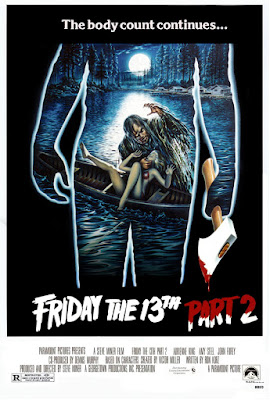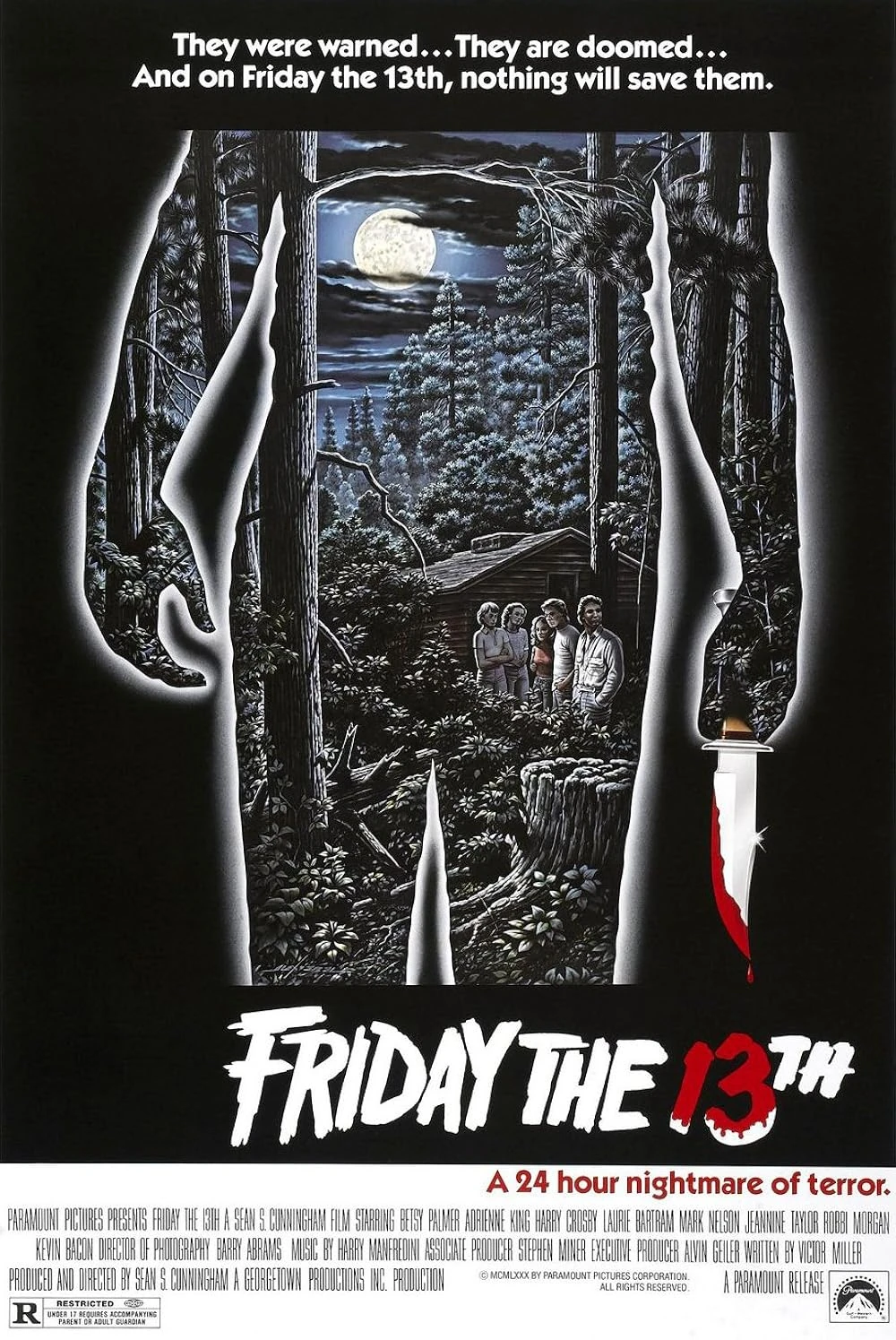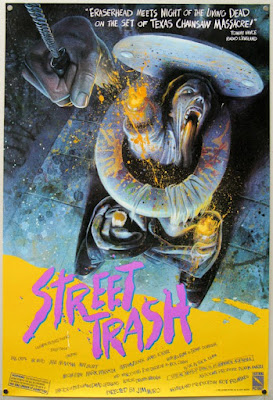 |
From http://www.adventuresinpoortaste.com/wp-content
/uploads/2014/04/street-trash-1987-cover.jpg |
Director: J. Michael Muro
Screenplay: Roy Frumkes
Cast: Mike Lackey (as Fred); Bill
Chepil (as Bill The Cop); Vic Noto (as Bronson); Mark Sferrazza (as Kevin);
Jane Arakawa (as Wendy)
 Synopsis
Synopsis: The streets of New York. Cheap, spoiled hooch sold in a liquor
store causes anyone who drinks it to melt into multi-coloured goo, and at a
local car junkyard a sociopath named Bronson (
Noto), a former Vietnam war veteran, rules with violence causing a
local cop Bill (
Chepil) to be
snapping at his heels. Amongst such atrocities as a severed penis being used as
a catch ball, spontaneous human meltdowns and a gangster Nick Duran (
Tony Darrow) wanting revenge for his
girlfriend being found dead at the junkyard, two brothers Fred (
Lackey) and Kevin (
Sferrazza) attempt to survive in vagary in their house made of
tires.
Street Trash is a film which requires caution for anyone not used
to this type of exploitation cinema that deliberately strives for bad taste. While
the retrospective documentary The
Meltdown Memoirs (2006) does ease its more controversial content knowing a
great deal of the cast looked back on the film with fondness, that should not deceive
potential viewers that the experience is exactly like drinking a bottle of the
tainted hooch in terms of how raw it can be. In terms of American cult cinema,
I am finding myself drawn towards a unique period that, while there were
similarierly grimy films to be found in the sixties and so forth, really starts
in terms of the specific mood I'm interested in from the late seventies to the
end of the eighties, or at least to Frank
Henenlotter's Frankenhooker (1990).
Particularly with New York set films, before the mayoral election of Rudy
Giuliani as mayor lead to what many documentaries on grindhouse cinema called
the "clean up" of the city, this type of cinema which were blurry in
what genre they all existed in had a potency to them, feeling like taking a
stroll on the real streets with the pimps and small hoods, and occassionally
even a swan dive into the gutter of humanity whilst they were there. Technically
films existed before including highly regarded works like Taxi Driver (1976),
but in terms of genre cinema which was thriving at this time, something like Abel Ferrara's The Driller Killer (1979) is the start of it for me. Ferrara himself and the aforementioned Henenlotter were putting out a lot of
films in this style, amongst other directors, but you also have one-offs
plotted through the eighties like Buddy Giovinazzo's Combat Shock (1984) and Street
Trash itself, films which even in lurid plotting and exaggerated realities
still filmed on real run-down streets and dealt with subjects like traumatised
Vietnam War vets and the sex industry, even if glibly, that serious dramatic
cinema were.
 |
From http://photos1.blogger.com/x/blogger/
3211/2829/1600/383657/stinkybum.jpg |
Street Trash is superficial with its subject of homelessness, something
that has to be pointed out after that paragraph to avoid confusion, connecting
more to the splatstick subgenre of splatter and humour that came about in the
mid eighties with a really sick humour. You cannot argue like with a film like Combat Shock that this has more on its
mind. But with all these films I've mentioned, even the fact that they bring in
this type of content and grime laced atmosphere still gives them a credibility,
enveloping the viewer in the environments and dirt of the locations here as it
wallows in its own filth. Unusually, Street
Trash is largely set in the broad daylight, but that doesn't stop the
(clearly real) dilapidated locations and wasteland from feeling like verité
realism even with its deliberately schlocky subject matter taking place in the
locations. This is definitely the case with how Street Trash is freewheeling in terms of plot as well, more of a
variety of characters - the rundown, the physically disabled or drink stuporous,
the ones with frayed sanities - and
strange atrocities rather than a clear narrative drive, very much the thing
that will also put off people alongside the content itself. Unlike other films
which are deliberately arch and gleefully mucking around in tastelessness
however, there's a greater sense of personality here even in its exceptional crass
even in end credit names. It's a film where the cast feels like they've walked
off the streets which many actually did, from Bill the cop being played by Bill Chepil, an actual former cop, to former
nightclub performer Tony Darrow as a
gangster who with James Lorinz, playing
a doorman and also the lead in Frankenhooker,
steal the film whenever they're onscreen with largely improvised dialogue.
Unlike some of the mainsteam genre films from this time, this film even with an
absurd premise feels far more realistic in tone through its casting, the low budget
and on-location choices.
 |
From https://pic.yify-torrent.org/1987/32448/
3555bd3ecedb469d9778344cd1cc7a56.png |
Street Trash has a lot that could easily offend still. The melt
sequences while gross are actually gleeful spectacles of practical effects and
rainbow slime; no matter how gross they are, they're far more humorous in an
incredibly twisted way especially with the ingenuity with depicting them
onscreen.. It's the other infamous moments which are likely to be problematic and
difficult to defend, such as a woman (Miriam
Zucker) being brought to the junkyard drunk for a casual sex romp, only to
be (off-camera) gang raped and killed, her body involved in a gruesome joke
afterwards. This sort of scene is understandably problematic, even if it's
meant to deliberately transgress. A great deal of this issue is that a film
like this is stuck swimming against the tide with what else was taking place in
this era, works with not helped by being part of the tide of works from this
era with far less qualities and little to defend unlike Street Trash which had worse attitudes about women and did similar
scenes; Street Trash even if
defendable stuck in the current alongside the literal trash by covering the
same ground. Whether you could defend the scene or not, a film like Street Trash that desires to offend
everyone on purpose suffers from the social context of when it was made when
people made comments seriously that were reprehensibly misogynistic without,
making the act of defending a film like it even more difficult. It does soften
the blow and put an entirely new perspective on the entirety of Street Trash having seen The Meltdown Memoirs though, both in how
actress Zucker has a prominent role
in the doc as a talking head, with no shame about the small role, and in small
details of how, when she had to lay naked on the side of a "toxic"
river in the gruesome after scene, women in the film crew were stood on a hill
off-camera to make sure she was okay during the filming. It complicates what
these troublesome scenes mean, both in their desire to attack the viewer
through transgression, and how in this case the production filming the scenes
with actors role-playing and the scenes in context on-screen contrast
drastically from each other, complicating the morality involved. This as much
applies to other potential problematic issues such as how the homeless are
depicted and the various forms of mutilation and chaos that are likely to
offend people throughout the movie.
 |
| From https://videoth.uloz.to/9/m/b/x9mb7nE.640x360.2.jpg |
Technical Details:
One of the most pronounced
aspects of Street Trash as an
exploitation film is its technical quality.
Notably, director Jim Munro
invested in a Steadicam before the
film started to be pre-produced and honed his own skill in handling one when
such technology was new for cinema, he himself using the camera and leading to some
incredible moments involving gliding camera moments you never expect in this
type of cinema. Munro, after only
directing this film, went on to become one of the most prolific cinematographers
and Steadicam operators in mainstream
cinema, from the films of James Cameron
to Kevin Costner's Open Range (2003) as a result of the
practice he shows here. Generally, for a low budget production, pains were
clearly made to bring a high technical quality to the whole film. From
storyboarding scenes to the elaborate and incredibly gross melt sequences, Street Trash is a whole calibre higher
in quality than a lot of this type of genre cinema; compare it to something
from around the same time like Class of
Nuke 'Em High (1986) - flat cinematography, constant blaring of cheap glam
metal, lack sure presentation - the carefully crafted nature of this film, even
if it's just as grimy, is incredibly noticeable.
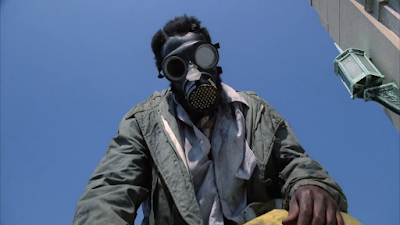 |
From http://67.media.tumblr.com/5f9d1c2f56ae5b0bdae0449431a62968
/tumblr_nmfu2eQ5Lv1r344y9o6_1280.png |
Abstract Rating (High/Medium/Low/None): None
The one debate with rating this
is whether "weird" has to qualify as a mood that disorientates the
viewer or if seeing a hobo melt into a toilet is enough to qualify for the list.
The issue with the latter is that this has to be a consistent, constant experience,
were sights never expected to be seen on-screen are seen, to be
"abstract". For a person who has never seen a film like Street Trash before, it would be an
incredibly weird experience in parts not to mention shocking. But the series of
events that take are is more shocking that bizarre to experience, merely the
poisoned hooch leading to anything remotely strange consistently particularly
with how the melting is depicting in bright primary colours specific to each
victim's scene, by themselves memorable just for their bright coloured
gristliness. The rest is far more a gritty and sickly hilarious series of
memorable characters and events, such following the likes of Burt (Clarenze Jarmon), a friend of the main
brothers who tries sneaking chicken and food from a grocery store in his
trousers in a memorable scene, to Bronson the main villain, who keeps a knife
made from a human thigh bone and has the only other moment that could be close
to "abstract", a nightmare about Vietnam where he's attached by
vampire Vietcong and has erotic desires for a captive he finds, the film
managing to make a location in the East Coast of the US look like an
appropriately nightmarish location for a battleground.
Abstract Spectrum: Grotesque/Psychotronic
Abstract Tropes: Body Horror;
Transgression; Melting Body Parts; Genital Mutilation; Bad Taste; Wallowing in
Filth
 |
| From http://www.freewebs.com/september-java/street%20trash.JPG |
Personal Opinion:
Unless you're prepared to see Street Trash or have been warned what
to expect, I advise caution with viewing the film even for splatter fans. The
film was intended to be like scrapping the bottom of the barrel and whilst there
are moments that are cheesy, there's still a lot of this which feels like
inserting one's head into an un-flushed toilet in a public bathroom even in the
present day. It was a film I didn't like at all when I first saw it, but Street Trash has gained a grimy quality
both for the charisma behind this seediness and the exceptional technical craft
that put it all together. The likes of Street
Trash could never be made again and a great deal of this is to do with the
character of these films in appearance and tone; rundown, economically effected
environments could be found to film at, but it would have a different tone to
it from the cultural and social changes that have taken place since the
eighties, let alone the influence of technology, leaving a film like this one
as something utterly distinct even if it has a bitter taste to it.

 With this film I get to enter the
world of Kazuo Umezu for this blog. Unfortunately
he's not as easily accessible as Junji
Ito is in terms of his manga being available in English, much of it only
published in the USA and now out of print, but he's a very important name in
horror manga. As memorable for being Where's
Wally's (Waldo's) cousin,
obsessed with the colours of barber shop red and white stripes, as he is for
his work Umezu has been penning
ghoulish horror stories since the fifties. This isn't the first time I've
personally seen an adaptation of his work - having to thank obsessive Western
anime fans for making a VHS rip available on the net for The Curse of Kazuo Umezu (1990), a straight-to-video anime of sixty
minutes based on two of his stories, with English subtitles - but this is the
first one which has the added delight of being a live action Japanese genre
film during the golden era of the sixties. From the multi colour nightmares of Jigoku (1960) to Nikkatsu's gangster
films, the sixties were an exceptionally strong decade for Japanese cinema both
for art and entertainment, the strangest of films having as high a technical
quality as the artistic minded dramas.
With this film I get to enter the
world of Kazuo Umezu for this blog. Unfortunately
he's not as easily accessible as Junji
Ito is in terms of his manga being available in English, much of it only
published in the USA and now out of print, but he's a very important name in
horror manga. As memorable for being Where's
Wally's (Waldo's) cousin,
obsessed with the colours of barber shop red and white stripes, as he is for
his work Umezu has been penning
ghoulish horror stories since the fifties. This isn't the first time I've
personally seen an adaptation of his work - having to thank obsessive Western
anime fans for making a VHS rip available on the net for The Curse of Kazuo Umezu (1990), a straight-to-video anime of sixty
minutes based on two of his stories, with English subtitles - but this is the
first one which has the added delight of being a live action Japanese genre
film during the golden era of the sixties. From the multi colour nightmares of Jigoku (1960) to Nikkatsu's gangster
films, the sixties were an exceptionally strong decade for Japanese cinema both
for art and entertainment, the strangest of films having as high a technical
quality as the artistic minded dramas. 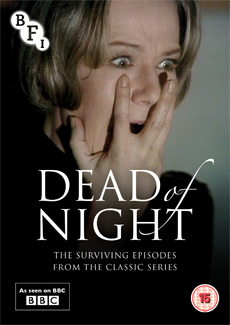


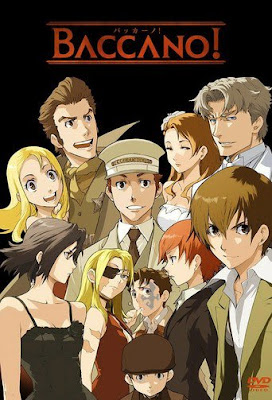
















.jpg)



